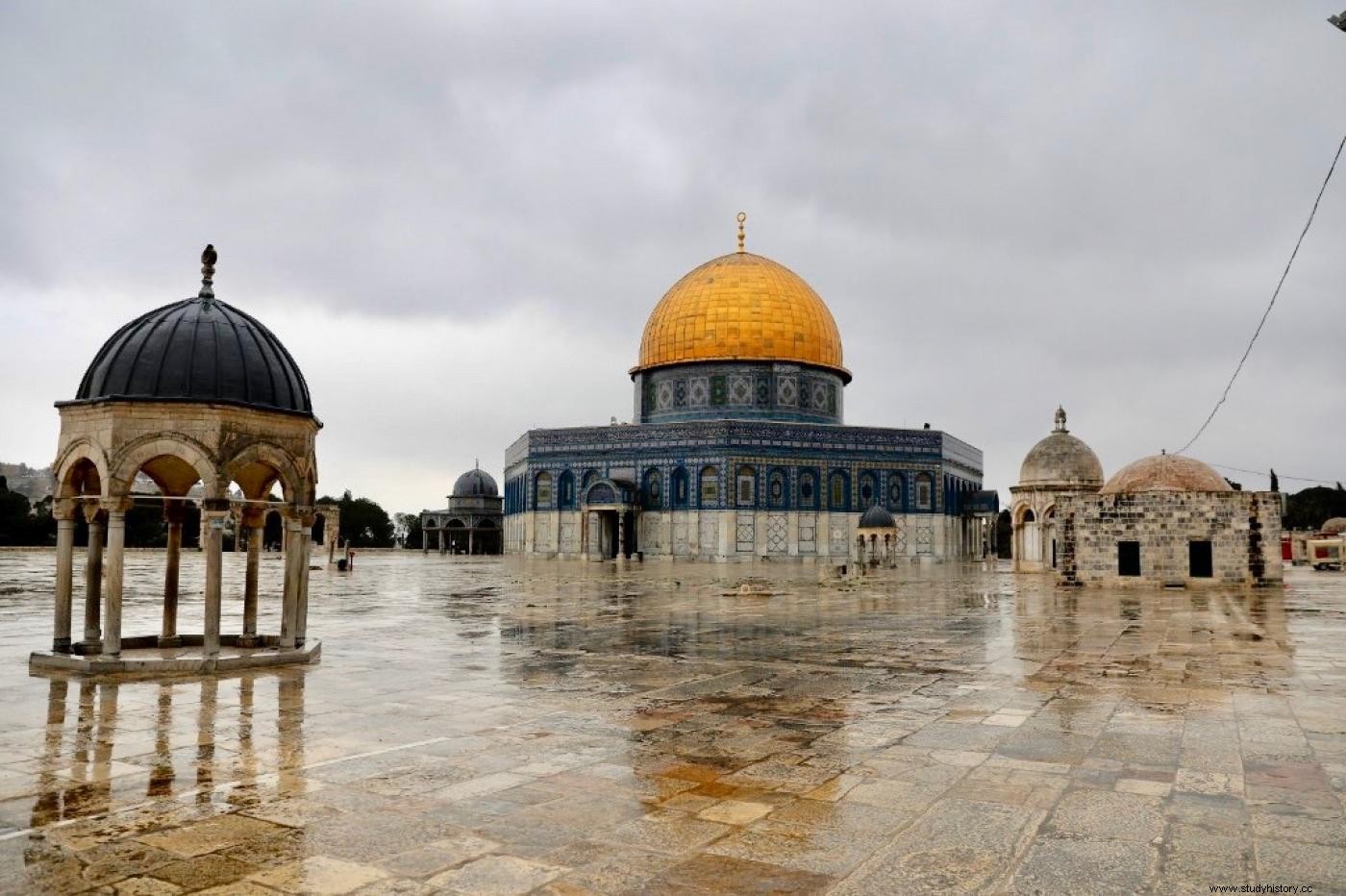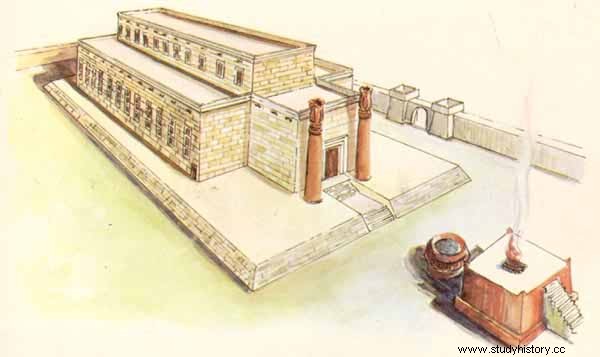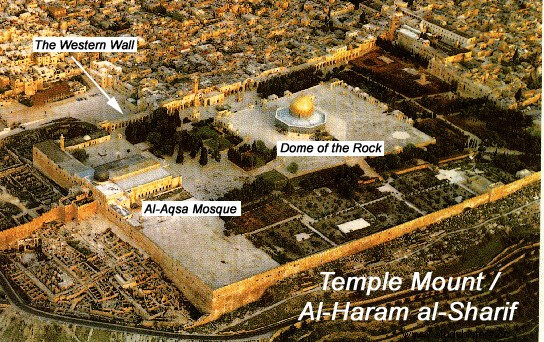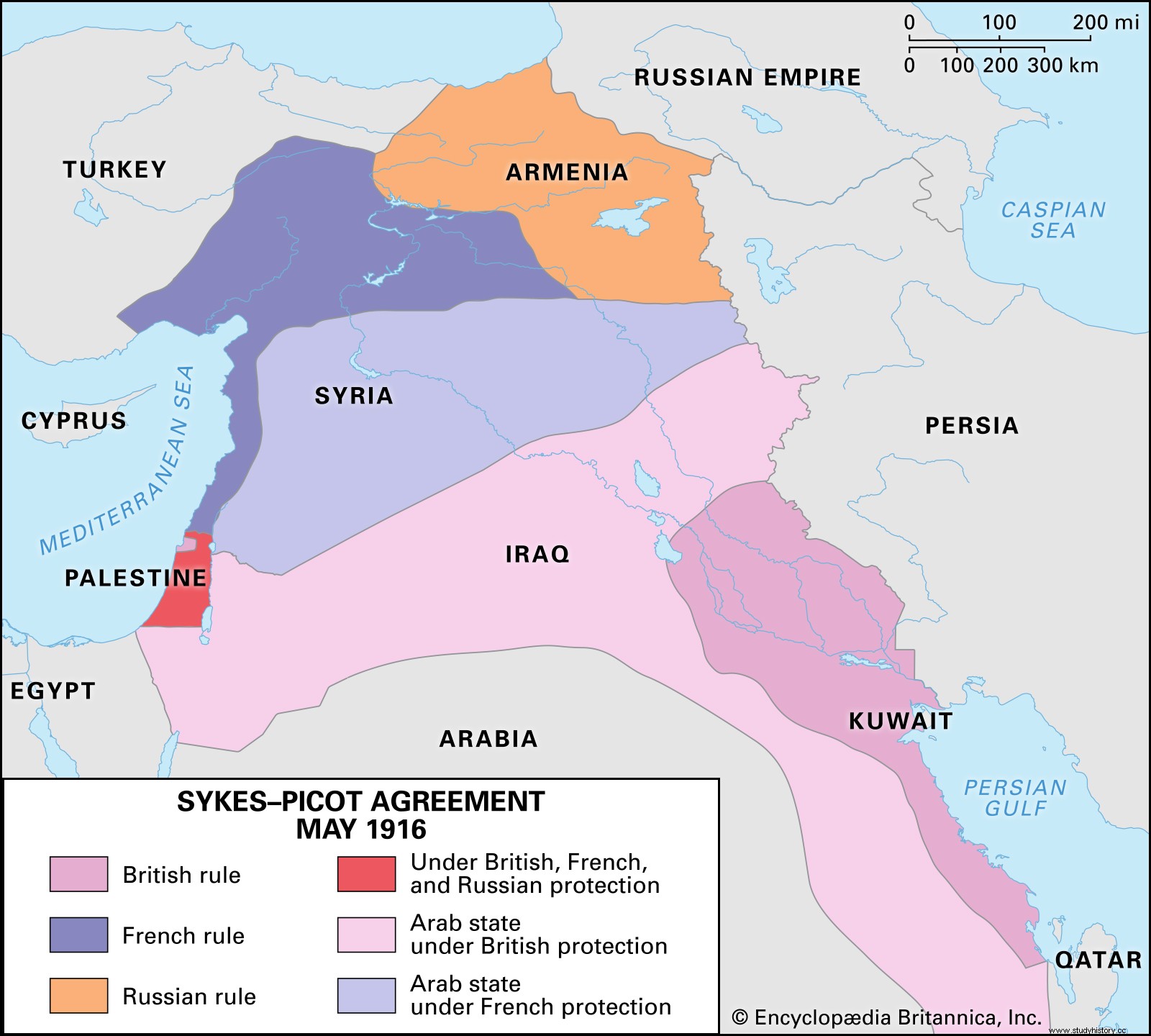The Al-Aqsa Mosque is an Islamic sanctuary located in the al-Haram ash-Sharif district of Jerusalem, Palestine. It is a sacred place for both Muslims, Christians and Jews and has thus been a source of heavy conflict between Palestine and Israel for the last century. Both sides want it under their control, and foreign policy, mainly from Britain, the United States and the rest of the Arab world, has had a huge impact on local politics.
Religious significance of al-Masjid al-Aqsa in Islam
For Muslims, the al-Aqsa Mosque (المسجد الأقصى) is the third holiest site in the world, after Mecca and Medina. The name means "the longest mosque", and it is believed to be where the Prophet Muhammad traveled during his night journey (الإسراء والمعراج). Before Muhammad and his followers left Mecca due to prosecution, it was the direction they prayed in, until Allah instructed the Prophet to pray to the Kaaba in Mecca.
The Al-Aqsa Mosque is also the second mosque built in the history of Islam, after the Holy Mosque in Mecca. It is located in the district of al-Haram ash-Sharif (الحرم الشريف), which also houses the Dome of the Rock (قبة الصخرة), believed to be the place where the Prophet Muhammad ascended to heaven. In Islamic tradition, the entire area within the walls of al-Haram ash-Sharif is seen as a single place.
Al-Masjid al-Aqsa is a place of pilgrimage for many Muslims around the world, but since it is controlled by Israel, Muslims need a special permit to gain access. In most cases, this permission is denied by the Israeli authorities. Only people over 60 have access. Jewish settlers and tourists, on the other hand, are escorted by soldiers and have free access.

Religious significance in Judaism
Jewish tradition says that the district of al-Haram ash-Sharif is the third temple, the holiest site for their religion, to be built. It was King Solomon who built the first Jewish temple, known as the Temple of Solomon (בֵּית־הַמִּקְדָּשׁ), in the seventh century BCE However, the Babylonian king Nebuchadnezzar conquered Jerusalem in 586 BCE In 516 BCE, the second temple (בֵּית־הַמִּקְדָּשׁ הַשֵּׁנִי) was built, but it was also burned in 70 AD. of Titus, son of the Roman emperor Vespasian.
There has been no other Jewish temple there in the last 2000 years, because Jerusalem has changed owners between the Romans and the caliphates throughout history and kept Jews away. According to tradition, the only part of it that still stands is the Buraq wall (הַכּוֹתֶל הַמַּעֲרָבִי, Western Wall), and thus Jews pray there today. Many of these Jews, the more orthodox of them, believe that they must build the third temple (the Third Temple) in order to fulfill the biblical prophecy of the Messiah's return.
Today, and since the Six Day War of 1967, Israel has been illegally occupying Jerusalem and most areas of Arab Palestine. The country's orthodoxy has wanted to build this temple, but they have met with international disapproval because the site they intend to work on currently houses the Muslim Dome of the Rock and the al-Aqsa Mosque.
Yet many scholars claim that the Jewish temples never stood on this site. For example, in a documentary narrated by Christopher Glyn, the eschatologist Robert Mandlebaum refers us to 2 Samuel 24:21 in the Bible, which states that the place consists of a "threshing floor." Thresh floors are used by farmers because the soft soil is suitable for plants, very different from the hard rock under the Klippekuppelen. He rather argues that it stood in the spring of Gihon, because, he says, it is the only place within five square kilometers of Jerusalem where there is a stream, a river and a stream, all referred to in various verses of Nehemiah (b. eg 2, 3 and 7). According to an archaeologist in the documentary, this confusion comes from the misinterpretation of a Christian conqueror in 1099 AD

History and origins of the al-Aqsa Mosque
The al-Aqsa Mosque was originally built as a small house of prayer, but in 703 AD. Umayyad Caliph Abd al-Malik and his son al-Walid rebuilt it, making it a major sanctuary where Muslims could pray. It was destroyed by an earthquake in 746 CE and again in 1033 CE, but various Islamic caliphates rebuilt it throughout history, adding pieces around it as minarets and expanding the area.
In the nineteenth century, Roman Christians and Muslims fought the Holy Crusades for Jerusalem. During these wars, in the year 1099 AD, the Christians invaded the mosque and used it as a palace. The first sultan of Syria and Egypt, however, Sultan Saladin, took it back almost a century later, in 1187.
British control
The Al-Aqsa Mosque and the al-Haram Ash-Sharif connection were under the Ottoman Empire until its fall in World War I. During World War I, Britain needed help to fight the Ottomans, and they exploited existing tensions between Arab subjects and Turkish elites to persuade Arabs to rebel against their Ottoman rulers, promising to support them in establishing an independent Arab stat. These uprisings were led by Sharif Hussein of Mecca and his sons Faisal and Abdullah, who successfully defeated the Ottomans and claimed independence.
Due to economic, political and military interests, however, the British stood at the same time as the Jews. Important and powerful figures such as Rothschild, a family of European Jewish aristocrats, helped Britain and the allied powers in World War II, and in return Britain, through the Sykes-Picot Agreement and later the Balfour Declaration (see the Agreements section below), supported the Zionist movement . This Jewish movement aimed to establish a Jewish state in the biblically promised land, a correspondent for Palestine.
The British began to facilitate Jewish settlements in Jerusalem, and in 1929 the Palestinians demonstrated in front of the Buraq Wall (Western Wall) against what they perceived as a growing Jewish occupation. This was because Jewish rituals involved playing trumpets and sacrificing animals, and Muslims viewed this as a desecration of the al-Aqsa Mosque. This gave rise to the first Arab popular demonstration of the Jewish occupation.
After the British left
In 1947, Britain left Palestine. It had just ended World War II and was occupied with reconstruction. Tensions in Palestine had also increased due to the large number of Jews who emigrated from Europe due to the Holocaust in World War II. This state caused Britain to lose control of Palestine to the Jews, and without knowing how to react, they left the colony. Around this time, the newly created UN proposed the partition plan for Palestine, also called Resolution 181. Under this plan, the Arabs would control half of the Palestinian territory and the Jews would control the other half. The disputed city of Jerusalem would be given to international leadership under UN responsibility.
The Jews were happier with this plan than the Arabs were. In perspective, the Jews got half of what they wanted while the Arabs lost half of what they had owned. As a result, just two days after the UN plan was presented, neighboring countries in Arab countries declared war on the Jews. This was the First Arab-Israeli War . Israel, aided by its allies in Britain and now also the United States, won the war and conquered about 50% more Palestinian land than the UN partition plan had provided. In 1949, the state of Israel was declared. This year, Arabs know al-Nakba (النكبة), which means disaster, because large masses of Palestinian Arabs were forced out of the country.
Status quo for the al-Aqsa Mosque
In 1967, Israel invaded East Jerusalem and claimed the city as its capital, although no other country has recognized this right. Negotiations with neighboring Jordan conclude that Israel may have control over the outside of the mosque, but the interior is under the control of the Jordanian government. Legally, only Muslims are allowed to pray there, but anyone can access it outside of prayer times.
However, the Israeli military has increasingly restricted Muslim access to the sanctuary and allowed Judaism, claiming that the law, by not allowing Jews to pray, is unfair. The city of Jerusalem is similarly subject to Israeli policy enforced by the authorities.

The agreements
Sykes-Picot
On 16 May 1916, Sir Mark Sykes and François George-Picot signed an agreement to divide the Middle East into British and French domains after the fall of the Ottoman Empire. The colonial powers wanted to secure their dominance in the area, and especially the British wanted to retain power over the Suez Canal between Egypt and the Sinai Peninsula, which was their shortcut to the colonies and oil reserves in India.
The map produced by Sykes and Picot ignored local identities and pre-existing political and ethnic tensions. By mixing these identities into a kind of forced marriage, Sykes-Picot provoked various forms of nationalism such as Nazarism, pan-Arabism, pan-Islamism, etc. Even Caliph Abu Bakr al-Baghdadi said in 2014 that the caliphate's blessing would not end "until we hit the last nail in the coffin of the Sykes-Picot conspiracy "(Wright, The New Yorker, 2016). But the precondition for all the efforts of outside powers such as the United States and Britain to deal with the Middle East is to preserve the borders that Sykes-Picot imposes.

The Balfour Declaration
In 1917, Arthur James Balfour, British Secretary of State, issued a letter expressing British support for Zionism (that Palestine should be a Jewish national home). This was only to bring Jewish opinion to their support because the allied powers (Britain, France, USSR) wanted them as allies in the First World War.
In 1922, the declaration was approved by the League of Nations, and its plans are presented, but it is made clear that there will be no prejudice against the existing non-Jewish communities in Palestine. In 1947. The UN issues Division Plan / Resolution 181 :Divide Palestine in half for Muslims and half for Jews, while placing Jerusalem under international control. As Muslims saw it, the plan favored the Jews by legitimizing the emergence of a Jewish state.
Britain began to limit the number of Jews allowed to settle in Palestine per year when they saw the tensions that arose from Arab society as a consequence, and Israel saw this as betrayal. Britain had trained Israeli soldiers to help them in the wars, and now the Israelis used this and their economic power to fight Britain, which was not in its prime, which had recently ended World War II and had not recovered. The British thus left Palestine.
Egypt, Syria, Iraq, Jordan, Lebanon and Saudi Arabia declare war on Israel (the first Arab-Israeli war) following the announcement of the partition plan, which was seen as theft. Israel, backed by Britain and the United States, wins the war and conquers large parts of Palestine (almost 50% more territory of it than the original UN declaration gave it). That is when the state of Israel is created. Second Arab-Israeli wars occur when Nasser nationalizes the Suez Canal. Israel attacks, but loses. However, Israel gains confidence in its military capabilities, which span things in Palestine.
on Six Day War in 1967, Israel captures the West Bank and East Jerusalem from Jordan, the Sinai Peninsula and the Gaza Strip from Egypt and the Golan Heights from Syria. The UN intervenes to implement a ceasefire. Israel claims Jerusalem as its capital, but no nation in the world recognizes this decision, even though the United States under Trump recently wants to go that route.
A view from anthropology
The Al-Aqsa Mosque has been a point of constant unrest, especially since the 1920s. The high religious significance has made it the focus of many political powers throughout history. It has been fought for by Jews, Muslims and Christians, and even by military powers for its strategic position. Al-Masjid al-Aqsa is one of the main reasons that inspires Muslim resistance today. As a sacred place, it connects them with their history, whether it is reality or narrative, and in this way gives them identity. By coexisting in harmony with a symbol of their religion where their prophet ascended to heaven, they coexist with God and heaven itself.
The problem is that the same thing happens to Jews. The third temple will be the materialization of how history should be, the fulfillment of human endeavors. After 2000 years of privatization, the Jews found an opportunity to achieve this in the powers of the 1920s, which practically needed them for their money, and began to take the land they considered their rightful. Arab refusal to give them it has caused increasingly violent relations, but Israel has always had military and economic superiority, in addition to benefiting from the European powers.
References:
Balfour Declaration:https://www.yoair.com/blog/history-sheikh-jarrah-and-the-israeli-palestinian-conflict/
Al-Aqsa Sharing:https://www.youtube.com/watch? V =DN3xyimKF0k &t =417sDocumentary by Christopher Glyn:https://www.youtube.com/watch?v=oKTO8YYs29c&t=2456sSykes-Picot:https:/ /www.youtube.com/watch?v=7VBlBekw3Uk
